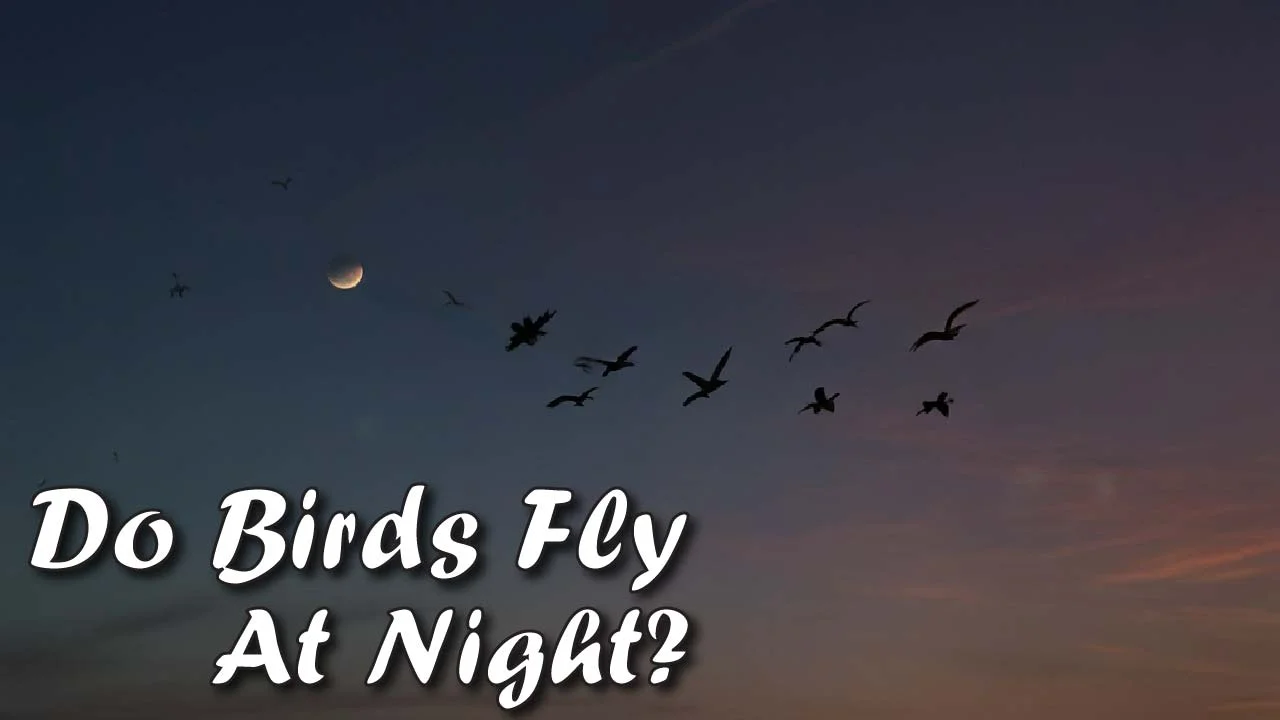With their ability to navigate the skies gracefully, birds have long been objects of fascination. While daytime flights are common, nocturnal flights remain a mystery to many. This article explores the world of nocturnal birds and their flight patterns, shedding light on this lesser-known aspect of avian behavior.
Do Birds Fly at Night?
Yes, most birds are diurnal, meaning they are primarily active during the day and rest at night. However, there are exceptions to this rule. Some bird species are known as nocturnal birds, which means they are active at night and rest during the day. Nighttime birds are good at living in the dark because they have special skills that help them stay safe and happy.
Examples of Nocturnal Birds:
-
Owls: Owls are perhaps the most well-known nocturnal birds. They have large eyes adapted for low light, allowing them to see clearly in the dark. Their feathers are designed for silent flight, enabling them to hunt silently and effectively.
-
Nightjars: They are insect-eating birds known for their cryptic plumage and aerial hunting skills. They are active at dusk and dawn and during the night, catching insects in flight with their wide mouths.
-
Night Herons: At night, some herons, like the black-crowned night heron, go hunting. They look for fish, crabs, and tiny creatures in marshes and wetlands.
Reasons Why Birds Migrate at Night:
Hunting and Foraging:
-
Prey Availability: At night, birds that like to sleep during the day fly to new places. They do this because the bugs and mice they want to eat are easier to find at night. Flying in the dark helps them find lots of food, so they have the energy to keep flying.
-
Adaptations for Night Hunting: Birds like to hunt at night and have special skills. They can see well in the dark and hear very well, too. This helps them find and catch food even when it’s dark outside. These skills make them better hunters than birds that hunt during the day.
-
Ecological Niche: Birds that like the night have their special place. They fly and hunt when it’s dark. This helps them avoid competition with other birds that like the daytime. They do this to find lots of food and stay alive.
Migration:
-
Temperature Regulation: Birds fly to new places at night to stay calm. Flying in the hot sun can make them tired and thirsty. But it’s more relaxed at night, so they can save energy and stay healthy for their trip.
-
Wind Assistance: Nocturnal migration allows birds to enjoy favorable wind conditions. Birds like to fly when the wind is gentle. At night, the wind is usually calm. This helps them fly more efficiently and use less energy for their long trip.
-
Reduced Predation Risk: Flying at night reduces predation risk by diurnal predators. Many bird predators, such as hawks and falcons, rely on daylight to hunt effectively. Birds fly at night to stay safe from predators. This helps them get to where they’re going without getting caught.
Avoiding Predators:
-
Reduced Visibility for Predators: Night-flying keeps birds safe from daytime predators. It’s dark, so predators can’t see them well. This helps the birds avoid getting caught so they can stay alive while flying.
-
Increased Foraging Opportunities: When birds look for food at night, they don’t have to worry about daytime predators. This helps them find lots of food without being scared. They eat enough to have energy for their long trip.
-
Optimal Foraging Conditions: Birds that like the night can find food easily because there aren’t many other birds around. During the night, most birds sleep, so the night birds have plenty of food to eat. This helps them get enough energy for their trip and stay safe while they fly.
Factors Influencing Nocturnal Flight
Environmental Conditions:
-
Weather Conditions: The weather affects when birds fly at night. Good weather, like when it’s not too hot or windy, makes birds want to fly. But if it’s raining or windy, they might stay put or change their plans until the weather improves.
-
Habitat Quality: Birds decide when to fly at night based on where they live. They prefer places with lots of food, good places to rest, and where they feel safe. Places without too much noise or danger let birds do what they need to do at night.
-
Seasonal Variation: Birds fly differently at night depending on the time of year. When days get longer or shorter, and it gets warmer or colder, birds change when and how much they fly at night. They also adjust their migrating birds plans based on the weather and where they can find food.
Biological Rhythms:
-
Circadian Rhythms: Birds have inner clocks that tell them when to do things like fly at night. These clocks help them know the best times to move, eat, and rest. They use these clocks to stay safe and find food, even when things around them change.
-
Migration Timing: Birds’ inner clocks help them know when to start and finish their trips at night. They use these clocks to match the changes in daylight and temperature. This allows them to save energy and find their way better when flying far away.
-
Adaptations to Day-Night Cycles: Birds that fly at night have special skills to help them. They can see well in the dark and hear very well, too. They use less energy and can find food quickly. These skills work well with their inner clocks, helping them stay strong and safe while they fly at night.
Types of Nocturnal Flight
Straight-Line Migration
-
Direct Route: Some birds fly in a straight line without stopping from where they make babies to where they spend the winter.
-
Efficient Travel: Birds fly without stopping to save time and energy.
-
Long-Distance Travelers: Swifts and some shorebirds fly for a long time without stopping. They travel thousands of miles in one go.
Circular Migration
-
Stop-and-Go Travel: Birds fly in circles when they move from one place to another. They stop a lot to rest, eat, and get more energy.
-
Strategic Resting Points: Birds stop at places like wetlands and coasts to rest and eat before going on their trip.
-
Flexibility and Adaptability: During circular migration, birds can change where and when they fly. This helps them stay safe and make it through their journey.
Altitudinal Migration
-
Vertical Movement: Some birds fly up and down mountains to find food and avoid bad weather.
-
Mountain Habitats: Some birds go high at night to find food like bugs, fruit, and sweet juice. Then, they come down to lower places to sleep during the day.
-
Optimizing Foraging Opportunities: Birds move around to find food and stay safe from bad weather and other animals that might try to catch them.
Challenges of Night Flight
Navigation Difficulties
-
Reliance on Celestial Cues: Birds use stars and the moon to find their way. But city lights can confuse them and lead them in the wrong direction.
-
Magnetic Field Disruption: Birds also rely on Earth’s magnetic field for navigation. But, things like power lines and communication towers made by people can mess up birds’ sense of direction, making it harder for them to know where to go.
Predation Risk
-
Nocturnal Predators: Night-time birds can be eaten by other animals that come out at night, like owls, hawks, and foxes. Flying at night makes them easier to catch because these animals are good at hunting in the dark.
Energy Expenditure
-
Balancing Energy Demands: Flying takes a lot of energy, especially when birds fly a long way for migration. Nighttime birds have to save energy but also fly well, especially when it’s stormy or they don’t know the area.
Technological Advances in Studying Nocturnal Flight
Radar Tracking
-
Detection and Tracking: Radar machines help scientists see birds flying at night. They see where birds go. They learn about the paths they take, how high they fly, and what they do.
-
Continuous Monitoring: Radar helps watch birds flying to see where they go in big areas. It tells us about their trips and where they take breaks.
GPS Tagging
-
Precision Tracking: Tiny GPS tags are put on birds. They track where the birds go. We learn about their trips, where they stop, and where they like to live.
-
Long-Term Monitoring: Scientists put GPS tags on birds. They watch where each bird goes for a long time. This helps them learn about the birds’ trips, where they like to live, and how they travel in different seasons.
Bioacoustic Monitoring
-
Sound Detection: Special devices record the sounds birds make. They tell us which birds are around, how many there are, and what they do.
-
Species Identification: We use special tools to listen to animals. These tools help us find them, especially when there are lots of plants or when it’s nighttime.
Impact of Artificial Light on Nocturnal Birds
Disruption of Natural Behavior
-
Altered Circadian Rhythms: Bright lights at night mess up the natural sleep schedule for some birds. This makes it hard for them to eat, find mates, and travel like they should.
-
Navigational Errors: Bright lights can confuse birds that like to be awake at night. They might accidentally run into buildings or tall towers because they can’t see well.
Adverse Effects on Health and Reproduction
-
Immune Function: Nightlights can make birds feel sick by weakening their bodies. This can make it easier for them to get sick.
-
Reproductive Success: Bright lights at night can bother birds, making it hard for them to make babies and build homes. This can cause fewer birds and make some kinds of birds disappear.
Conclusion
It’s essential to know how birds fly at night and the problems they deal with to help keep them safe. We can help them have a better future by using lights carefully and keeping their homes secure.
FAQs
Q. Can all birds fly at night?
A. Not all birds are adapted for nocturnal flight; some are primarily active during the day.
Q. How do nocturnal birds see in the dark?
A. Nocturnal birds have specialized vision and may rely on other senses, such as hearing and touch.
Q. Do migratory birds only fly at night?
A. No, migratory birds may fly during the day and night, depending on various factors.
Q. Are there any risks associated with nocturnal flight?
A. Yes, including navigation difficulties, predation risk, and energy expenditure.
Q. How can individuals help nocturnal bird populations?
A. We can help animals by turning off lights at night, saving their homes, and telling others why keeping their habitats safe is essential.

